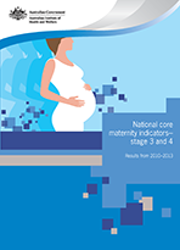Summary
The National Core Maternity Indicators (NCMIs) present information on measures of clinical activity and outcomes between 2004 and 2013. The purpose of the NCMIs is to monitor the safety and quality of maternity care to ensure that there is continual improvement in the quality of maternity services following the introduction of the National Maternity Services Plan (AHMC 2011). This report covers 10 indicators previously reported and 2 new indicators. Data are presented by jurisdiction, at the national level by hospital annual number of births, hospital sector, and mother's Indigenous status. Some indicators are presented by remoteness, disadvantage quintile and other disaggregations where relevant. From the 12 indicators, the following observations can be made.
During the antenatal period
- In 2013, fewer than 1 in 8 women (34,000 or 11.2%) smoked in the first 20 weeks of pregnancy, a decrease from 12.7% in 2011, and around one-quarter quit smoking after the first 20 weeks of pregnancy. However, around 26,000 (73.6%) women who previously reported smoking continued to smoke after the first 20 weeks of pregnancy, an increase from 2011. Most jurisdictions saw little change in smoking rates after the first 20 weeks of pregnancy.
- The proportion of women receiving antenatal care in the first trimester remained steady in the majority of jurisdictions between 2007 and 2013 with almost 128,000 women or less than two-thirds of women receiving antenatal care in their first trimester in 2013.
During labour and birth
- The proportion of first-time mothers for whom labour was induced increased by 5 percentage points from 31.1% in 2004 to 36.1% in 2013. This may reflect increasing maternal age and the pre-existing medical conditions that may have prevented the spontaneous onset of labour.
- From 2004 to 2013, the rate of unassisted vaginal births decreased while assisted vaginal births increased.
- In 2013, about one-fifth of women (almost 11,000 or 18.4%) received an episiotomy in an unassisted birth, an increase of 2.2 percentage points from 16.2% in 2004. In 2013, around two-thirds of women (around 21,000 or 69.6%) received an episiotomy in an assisted birth, an increase of 8.9% percentage points from 60.7% in 2004.
- The rate of caesarean sections in first-time mothers increased from 25.3% in 2004 to 27.5% in 2013 an increase of 2.2 percentage points, consistent with increasing trends observed in other developed countries.
- Despite the increasing caesarean rate in 2013, around 1 in 8 women (about 3,400 or 13.5%) had a second birth vaginally after having their first birth by caesarean section, an increase of 0.4 percentage points from 13.1% in 2007.
Birth outcomes
- In 2013, around 1.3% of babies (3,800) had an Apgar score of less than 7 at 5 minutes, an increase of 0.4 percentage points from 0.9% in 2004, which may be associated with maternal risk factors such as increasing maternal age and increasing maternal obesity.
- There was a decrease in the proportion of small babies born at or after term by 0.5% from 2.1 percentage points in 2004 to 1.6% in 2013.



